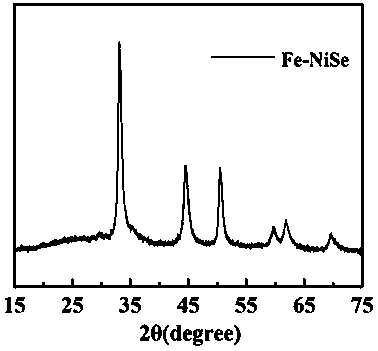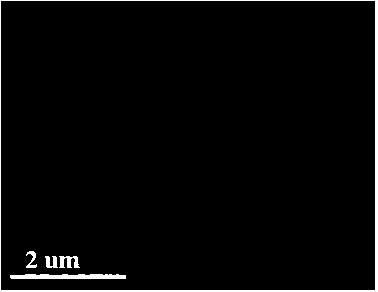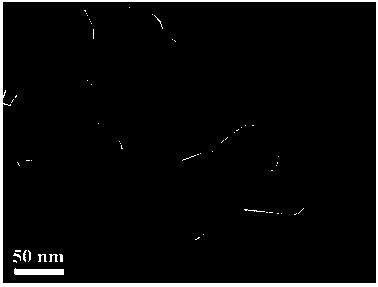Counter electrode of nickel iron selenide dye-sensitized solar cell
A technology for solar cells and dye sensitization, which is applied in the field of counter electrodes of iron-nickel selenide dye-sensitized solar cells to achieve the effects of superior catalytic performance, enhanced contact force, and reduced dosage
- Summary
- Abstract
- Description
- Claims
- Application Information
AI Technical Summary
Problems solved by technology
Method used
Image
Examples
Embodiment 1
[0016] Take 12mL of deionized water, put it in a beaker with a volume of 50mL, and add 0.025 mmol NiCl 2 ·6H 2 O, 0.05 mmol FeCl 3 ·6H 2 O and 0.1 mmol Se, 10 mL NH was added dropwise with constant stirring 3 ·H 2 O, 3mL N 2 H 4 ·H 2 O, after continuing to stir for 15min, transfer the solution in the beaker to the autoclave, place a piece of 1.5×3cm ITO glass conductive side down and place it at an angle of 45° with the inner wall of the reactor, the reactor is covered with a shell and placed in In a 120°C oven for 12 hours, the reaction was carried out at a constant temperature, cooled to room temperature naturally, taken out, rinsed with deionized water and ethanol for several times, and then air-dried to obtain a black iron-nickel-selenide counter electrode.
[0017] The remaining black precipitate in the kettle was centrifuged, washed three times with deionized water and ethanol, and freeze-dried for subsequent characterization.
[0018] figure 1 It is the XRD pat...
Embodiment 2
[0022] Take 10mL of deionized water, put it in a beaker with a volume of 50mL, and add 0.025 mmol NiCl 2 ·6H 2 O, 0.05 mmol FeCl 3 ·6H 2 O and 0.1 mmol Se, 10 mL NH was added dropwise with constant stirring 3 ·H 2 O, 2mL N 2 H 4 ·H 2 O, after continuing to stir for 15min, transfer the solution in the beaker to the autoclave, place a piece of 1.5×3cm ITO glass conductive side down and place it at an angle of 45° with the inner wall of the reactor, the reactor is covered with a shell and placed in In a 120°C oven for 12 hours, the reaction was carried out at a constant temperature, cooled to room temperature naturally, taken out, rinsed with deionized water and ethanol for several times, and then air-dried to obtain a black iron-nickel-selenide counter electrode.
Embodiment 3
[0024] Take 15mL of deionized water, put it in a beaker with a volume of 50mL, and add 0.025 mmol NiCl 2 ·6H 2 O, 0.05 mmol FeCl 3 ·6H 2 O and 0.1 mmol Se, 10 mL NH was added dropwise with constant stirring 3 ·H 2 O, 5mL N 2 H 4 ·H 2 O, after continuing to stir for 15min, transfer the solution in the beaker to the autoclave, place a piece of 1.5×3cm ITO glass conductive side down and place it at an angle of 45° with the inner wall of the reactor, the reactor is covered with a shell and placed in In a 100°C oven for 12 hours, the reaction was carried out at a constant temperature, cooled to room temperature naturally, washed several times with deionized water and ethanol, and then air-dried to obtain a black iron-nickel selenide counter electrode.
[0025] with commercial TiO 2 The slurry was used as a photoanode, and N719 was used as a sensitizer, and was assembled with the iron-nickel selenide counter electrode prepared in Example 1 to form a sandwich structure batter...
PUM
 Login to View More
Login to View More Abstract
Description
Claims
Application Information
 Login to View More
Login to View More - R&D
- Intellectual Property
- Life Sciences
- Materials
- Tech Scout
- Unparalleled Data Quality
- Higher Quality Content
- 60% Fewer Hallucinations
Browse by: Latest US Patents, China's latest patents, Technical Efficacy Thesaurus, Application Domain, Technology Topic, Popular Technical Reports.
© 2025 PatSnap. All rights reserved.Legal|Privacy policy|Modern Slavery Act Transparency Statement|Sitemap|About US| Contact US: help@patsnap.com



